CMS-Flow Multiple-sized Sediment Transport: Difference between revisions
| Line 16: | Line 16: | ||
# Size class limits | # Size class limits | ||
The characteristic diameters <math> d_k </math> are | The characteristic diameters <math> d_k </math> are calculated using the geometric mean of the lower <math> d_{l,k}</math> and upper <math> d_{u,k}</math> bin limits | ||
{{Equation| <math> d_k = \sqrt{d_{l,k} d_{u,k}} </math> |2=1}} | {{Equation| <math> d_k = \sqrt{d_{l,k} d_{u,k}} </math> |2=1}} | ||
The bin width is therefore given by <math> \del d_k = d_{u,k} - d_{u,k} </math>. | |||
The table below describes the CMS-Flow cards related to the grain size class information. | The table below describes the CMS-Flow cards related to the grain size class information. | ||
Revision as of 15:36, 22 January 2011
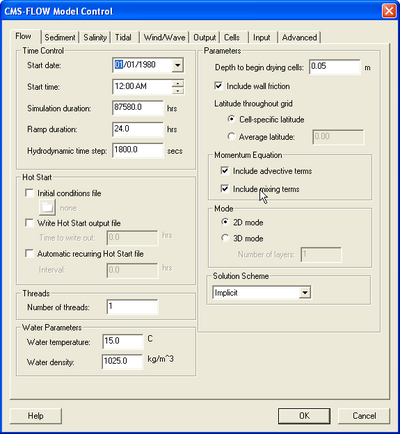
All of the CMS-Flow model parameters, settings, and output options are controlled from the CMS-Flow Model Control window (Figure 1). The window has several tabs including the Flow tab in which most of the general settings are set for CMS-Flow. To open the CMS-Flow Model Control window, click on CMS-Flow | Model Control. The first tab will be the Flow tab. There are several sections within the tab including Time Control and Hot Start options.
The input information for multiple-sized sediment transport can be divided into the following groups:
- Grain size classes
- Fractional bed composition
- Bed layer thickness
- Mixing layer
- Hiding and Exposure
Further details on each type of information is provided in the sections below.
Grain Size Specification
In the multiple-sized sediment transport model, the continuous grain sizes are divided into discrete bins or size classes. Each size class has a character diameter, and lower and upper limits. Because sediment sizes classes are transport from one cell to another the size classes must be constant over the whole domain. In CMS there are two options for specifying the grain size information:
- Characteristic diameters
- Size class limits
The characteristic diameters are calculated using the geometric mean of the lower and upper bin limits
| (1) |
The bin width is therefore given by Failed to parse (unknown function "\del"): {\displaystyle \del d_k = d_{u,k} - d_{u,k} } .
The table below describes the CMS-Flow cards related to the grain size class information.
Table 1. CMS-Flow cards related to the grain size classes
| Card | Arguments | Example | Description |
|---|---|---|---|
| SEDIMENT_SIZE_CLASS_NUMBER | INTEGER | 3 | Specifies the number of grain size classes. |
| MULTIPLE_GRAIN_SIZES | INTEGER [REAL, REAL,..., REAL] | 3 0.1 0.2 0.3 | Specifies the number of grain sizes followed by the grain sizes for each size class in mm. |
| SEDIMENT_SIZE_CLASS_DIAMETERS | INTEGER [REAL, REAL,..., REAL] | 3 0.1 0.2 0.3 | Specifies the number of grain sizes followed by the grain sizes for each size class in mm. Same as MULTIPLE_GRAIN_SIZES. |
| SEDIMENT_SIZE_CLASS_LIMITS | INTEGER [REAL, REAL,..., REAL] | 4 0.07 0.15 0.26 0.34 | Specifies the size classes limits. The first entry is the number of size class limits which is one greater than the number of size classes. |
Notes:
- It is only necessary to specify either the size class characteristic diameters or limits. The other will be calculated internally by the model.
Recommendations:
- Because each grain size requires the iterative solution of a separate transport formula, it is recommended to not use more 8-9 sediment size classes. For most cases, 3-5 sediment size classes is sufficient.
Fractional Bed Composition
Since the sediment size classes are constant for the whole domain, the bed composition is specified as the fractional amount of each size class per cell and per bed layer. In CMS V4.0 there are 5 options for specifying the fractional bed composition:
- Two-dimensional horizontal (2DH) D50 dataset plus spatially constant geometric standard deviation (option D50_SIGMA).
- 2DH D16, D50, and D84 datasets (option D16_D50_D84)
- 2DH D35, D50, and D90 datasets (option D35_D50_D90)
- Spatially (horizontally and vertically) constant size class fractions (option SIZE_CLASS_FRACTIONS)
- Fraction of each sediment size class for each cell and bed layer (option FRACTIONS_DATASET)
A description of the CMS-flow card used to select each bed material composition option is described in the Table below.
Table 2. CMS-Flow card used to specify the option for specifying the bed material composition
| Card | Arguments | Default/Format | Range | Description |
|---|---|---|---|---|
| BED_COMPOSITION_INPUT | CHARACTER | D50_SIGMA | D16_D50_D84 | D35_D50_D90 | SIZE_CLASS_FRACTIONS | FRACTIONS_DATASET | Selects the method for specifying the bed material composition. |
Further details on each option is provided in the sections below.
D50 Dataset and Standard Deviation
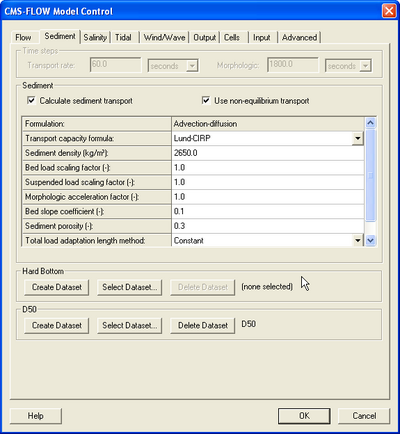
This is the simplest and easiest way to specify the bed composition for multiple-sized sediment transport in CMS because it only requires the D50 dataset which is already in the SMS interface and one extra parameter, the geometric standard deviation.
- Assumptions:
- The initial sediment sorting is constant for the whole domain
- The initial bed composition may vary spatially according to the D50 dataset but is constant with depth
- The initial grain size distribution can be approximated by a log-normal distribution
The geometric standard deviation can be defined using the method of moments
| (2) |
where is the fraction, is the size class diameters in mm, is the geometric mean in mm given by
| (3) |
An alternate approach to Equation 2 for obtaining geometric standard deviation is by using the graphical measures (cumulative percentile values) (Folk and Ward, 1957)
| (4) |
The size class fractions are calculated using log-normal sediment size distribution
| (5) |
Table 2. Sorting classification based on the geometric standard deviation (Folk and Ward, 1957)
| Geometric Standard Deviation | Sorting Classification |
|---|---|
| <1.27 | Very well sorted |
| 1.27-1.41 | Well sorted |
| 1.41-1.62 | Moderately well sorted |
| 1.62-2.00 | Moderately sorted |
| 2.00-4.00 | Poorly sorted |
| 4.00-16.00 | Very poorly sorted |
| >16.00 | Extremely poorly sorted |
A description of the CMS-Flow cards related to the D50_SIGMA option for specifying the bed material composition is provided in the table below.
Table 4. CMS-Flow cards related to the D50 dataset and standard deviation
| Card | Arguments | Default/Format | Description |
|---|---|---|---|
| D50_DATASET | CHARACTER CHARACTER | CHARACTER | [file name] [dataset path and name] | Specifies the D50 dataset file followed by the path and name. If the file name is not specified than it is assumed to be the grid file (*_grid.h5). |
| SEDIMENT_STANDARD_DEVIATION | REAL | 1.5 | Specifies the geometric sediment standard deviation for all cells and layers in mm. |
D16, D50, and D84 Datasets
The second approach for specifying the initial bed composition is using 2DH D16, D50, and D84 datasets. Because only the D50 dataset can be specified through the SMS interface, it is necessary to specify the additional datasets either through the Custom Input Datasets are by manually creating the datasets using the Data Calculator and exporting them to XMDF file(s).
- Assumptions:
- The initial bed composition may vary spatially according to the D16, D50, and D84 datasets but is constant with depth
- The initial grain size distribution can be approximated by a log-normal distribution
Table 3. CMS-Flow cards related to the D16_D50_D84
| Card | Arguments | Default/Format | Description |
|---|---|---|---|
| D16_DATASET | CHARACTER CHARACTER | [file name] [dataset path and name] | Specifies the D16 dataset path and file name. |
| D50_DATASET | CHARACTER CHARACTER | CHARACTER | [dataset path and name] | [file name] [dataset path and name ] | Specifies the D50 dataset path and file name. If the file is not specified than it is assumed to be the model parameters file name (*_mp.h5). |
| D84_DATASET | CHARACTER CHARACTER | [file name] [dataset path and name] | Specifies the D50 dataset path and file name. |
| CUSTOM_DATASET | CHARACTER CHARACTER | [file name] [dataset path and name] | Specifies a custom dataset path and file name. The custom dataset can be used for any additional user defined dataset. The name of the dataset must be equal to the variable name. For example the D16 dataset must be named D16 and cannot be myD16. |
Custom Datasets
The first approach of specifying the D16 and D84 datasets is by using the Custom Input Datasets section under the Input tab of the CMS-Flow Model Control window. The advantage of using this approach is that the user can edit the datasets once they are created without having to map each dataset as the Elevation dataset. It also avoids having to specify the dataset files and names manually in the *.cmcards file. The steps for creating and specifying the D16 and D84 datasets are outlined below:
- Open CMS-Flow Model Control window and go to the Input tab.
- To create the D16 dataset, click on the New buttom and a window will appear titled New Editable Dataset.
- Name the dataset D16 for the D16 dataset or D84 for the D84 dataset. The names must be correct for CMS to be able to interpret the dataset.
- Set the initial values by either specifying a spatially constant value or selecting a current dataset.
- Click OK in the New Editable Dataset window
- Repeat steps 2 through 5 for the D84 dataset.
- Click OK in the CMS-Flow Model Control window
- Save the CMS-Flow project
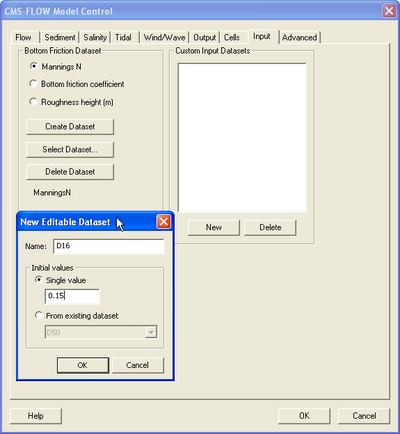 |
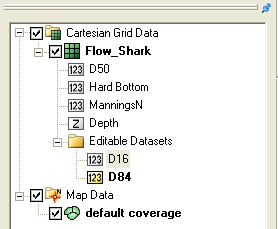 |
Once the datasets are created the SMS project explorer will show a folder with the D16 and D84 datasets.
After saving the CMS-Flow project the project folder will show a new dataset called Flow_Shark_input_datasets.h5 (see Figure below).
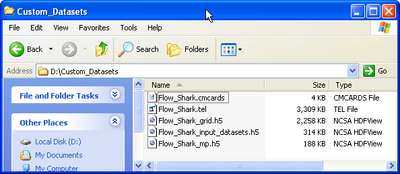
The data structure of the Flow_Shark_input_datasets.h5 file is shown in the Figure below.
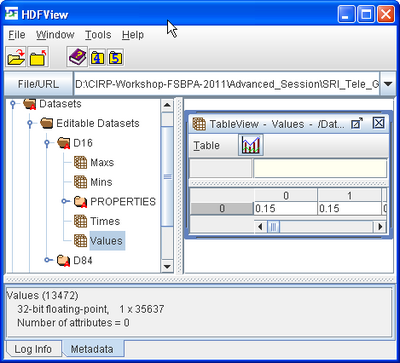
Exported Datasets
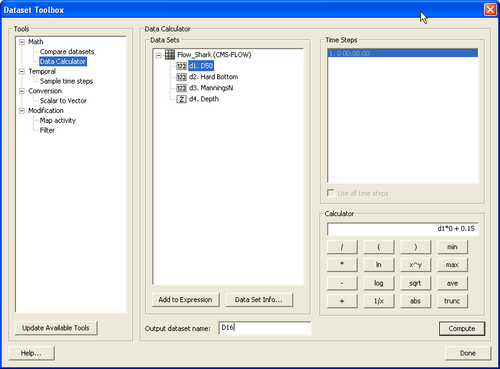
An alternate approach for specifying datasets is by exporting them into XMDF files and then specifying the file names and paths in the Advanced cards section of the *.cmcmards file. The advantage of this approach is that is allows more flexibility in specifying project alternatives and also works for SMS versions 10.1 and earlier.


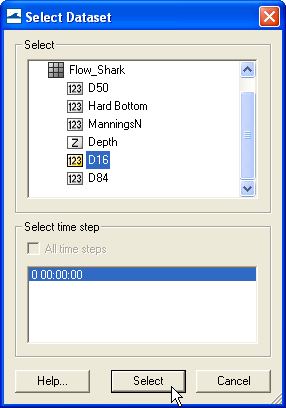

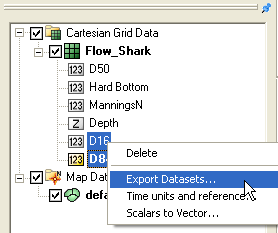
D35, D50, and D90 Datasets
- Assumptions:
- The initial bed composition may vary spatially according to the D16, D50, and D84 datasets but is constant with depth
- The initial grain size distribution can be approximated by a log-normal distribution
| Card | Arguments | Default/Format | Range | Description |
|---|---|---|---|---|
| D35_DATASET | CHARACTER | none | ||
| D50_DATASET | CHARACTER | none | ||
| D90_DATASET | CHARACTER | none |
Size Class Fractions
For this case, the fractional bed compositions are specified for each size class for all cells and all bed layers. The fractional bed compositions must sum to 1.0. This option is useful for simulating cases where the bed composition is well known and is constant both in the horizontal and vertical directions.
- Assumption:
- The initial bed composition is constant at every cell and layer for whole domain
| Card | Arguments | Example | Description |
|---|---|---|---|
| SEDIMENT_SIZE_CLASS_FRACTIONS | INTEGER [REAL, REAL,..., REAL] | 3 0.2 0.5 0.3 | Specifies the fractional composition for each size class and for all cells and bed layers. The first entry is the number of grain size classes. |
Fractional Composition Dataset
| Card | Arguments | Default/Format | Range | Description |
|---|---|---|---|---|
| BED_FRACTIONAL_COMPOSITION_DATASET | CHARACTER CHARACTER | [<grid file>] [<grid name>//"Datasets/<Name>"] | Fractional bed composition file. Necessary when setting BED_COMPOSITION_INPUT to FRACTION_DATASET. |
Bed Layer Thickness
Table 1. CMS-Flow cards related to the general parameters
| Card | Arguments | Default/Format | Range | Description | |
|---|---|---|---|---|---|
| BED_LAYER_THICKNESS_INPUT | CHARACTER | NONE | NONE | CONSTANT | LAYER_THICKNESS | LAYER_DATASET | ||
| BED_LAYER_THICKNESS_DATASET | CHARACTER CHARACTER | none | [file] [path] | Specifies the bed layer thickness file and dataset path. | |
| BED_LAYERS_MAX_NUMBER | INTEGER | ||||
| BED_LAYERS_CONSTANT_THICKNESS | INTEGER [REAL, REAL,..., REAL] | ||||
| BED_LAYERS_THICKNESS | INTEGER [REAL, REAL,..., REAL] | ||||
| BED_LAYERS_CONSTANT_THICKNESS | INTEGER [REAL, REAL,..., REAL] | ||||
| BED_LAYERS_CONSTANT_THICKNESS | INTEGER [REAL, REAL,..., REAL] |
Mixing Layer
| Card | Arguments | Default/Format | Range | Description |
|---|---|---|---|---|
| MIXING_LAYER_CONSTANT_THICKNESS | INTEGER [REAL, REAL,..., REAL] | |||
| MIXING_LAYER_MIN_THICKNESS | INTEGER [REAL, REAL,..., REAL] |
Hiding and Exposure Parameters
The general parameters are the water density and temperature. The CMS-Flow cards for the general parameters are described in the table below.
| Card | Arguments | Default/Format | Range | Description |
|---|---|---|---|---|
| HIDING_EXPOSURE_COEFFICIENT | REAL | 1025 | - | Water density in kg/m^3. |
| HIDING_EXPOSURE_COEFF | REAL | 15 | - | Water temperature in degrees Celcius. |
Boundary and Initial Conditions
| Card | Arguments | Default/Format | Range | Description |
|---|---|---|---|---|
| SEDIMENT_INFLOW_LOADING_FACTOR | REAL | 1025 | - | Water density in kg/m^3. |
| SEDIMENT_FLUX_CELLSTRING | REAL | 1025 | - | Water density in kg/m^3. |
Output Files and Datasets
| Card | Arguments | Default/Format | Range | Description |
|---|---|---|---|---|
| BED_OUT_TIMES_LIST | INTEGER | 1025 | - | Water density in kg/m^3. |
| SEDMIX_OUT_TIMES_LIST | INTEGER | 1025 | - | Water density in kg/m^3. |
Examples
- Example 1
SEDIMENT_MAX_ITERATIONS 30 SEDIMENT_STATISTICS 120.0 720.0 BED_COMPOSITION_INPUT D50_SIGMA MULTIPLE_GRAIN_SIZES 6 0.1 0.126 0.16 0.2 0.25 0.31 SEDIMENT_STANDARD_DEVIATION 1.3 BED_LAYER_CONSTANT_THICKNESS 0.5 MIXING_LAYER_CONSTANT_THICKNESS 0.1 MIXING_LAYER_MIN_THICKNESS 0.05 HIDING_EXPOSURE_COEFFICIENT 1.0 SEDMIX_OUT_TIMES_LIST 2 BED_OUT_TIMES_LIST 2 CALC_MORPH_DURING_RAMP OFF
- Example 2
SEDIMENT_MAX_ITER 30 BED_COMPOSITION_INPUT D50_SIGMA SEDIMENT_STANDARD_DEVATION 1.5 MULTIPLE_GRAIN_SIZES 5 0.08 0.12 0.17 0.28 0.45 BED_LAYER_CONSTANT_THICKNESS 0.5 MIXING_LAYER_CONSTANT_THICKNESS 0.02
References
- Folk, R.L., and Ward, W.C. (1957). "Brazos River bar: a study in the significance of grain size parameters", Journal of Sedimentary Petrology, 27, 3–26.